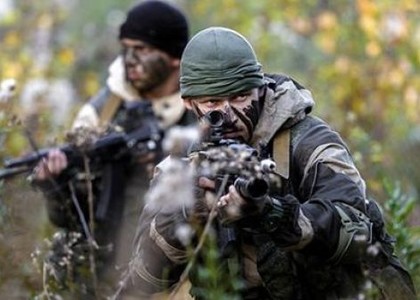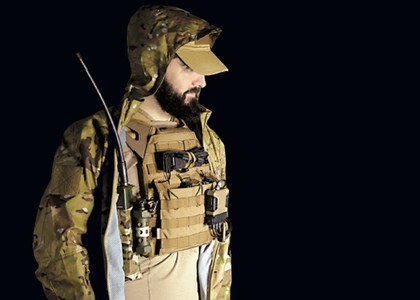CRU 222, Afghanistan’s Elite Anti-Terrorism Unit

This article was originally published at recoilweb.com by Robert Young Pelton

“No One Kills Terrorists as Fast as We Do”
Sheik Abdul Hasib is a stout Pakistani who chose to fight under the flag of ISIS in eastern Afghanistan. The area he chose as his redoubt is the border with Pakistan, not too far from where Osama bin Laden and the Arab-speaking jihadis chose to build caves and fight the Soviets in the ’80s. Now seeking to tax poppy growers in the Nangahar province and establish ISIS Khurahsan, the long-haired Pakistani Orakzai tribal fighters have been streaming over four mountain passes from the Khyber and Orakzai regions in Parchinar since 2015. Since then, they’ve terrorized the locals, beheading children and elders alike, and launched a number of violent attacks in Afghanistan.
 The Afghan anti-terrorist force began in Kabul and expanded to other major urban areas. Unlike the military, they’re trained by the world’s most elite counter-terrorism units to work in intense scenarios in which hundreds of civilians may be at risk.
The Afghan anti-terrorist force began in Kabul and expanded to other major urban areas. Unlike the military, they’re trained by the world’s most elite counter-terrorism units to work in intense scenarios in which hundreds of civilians may be at risk.
GROWING THREAT
ISIS established a foothold in the Pakistan tribal areas in mid-2014 with the fracturing of the “little T” Taliban that was made up of former Pakistan-based Taliban fighters. Leaderless, they flowed northward into Afghanistan in 2015 when around 70 ISIS trainers travelled from Syria to school them in tactics, public relations, and ambushes. Led by Abdul Rauf Khadem, a former bin Laden confident, ISIS began paying three times the Afghan government salary, and twice that of the Taliban. They launched their new sub brand, ISIS-Khurasan, with brutal videos of hapless villagers being blown up and other brutal filmed executions. Islamic religion tradition insists that horse-mounted jihadis carrying the Black Flags of Khurasan will signal the retaking of the Holy Land and the end of Christianity. Not surprisingly, ISIS PR cameramen filmed chubby Pakistanis jogging and jerking along on Afghan nags carrying black flags in their videos.
The cash and the PR campaign worked. In September 2015, the UN estimated ISIS penetrated 25 out of the 34 provinces.
 The Crisis Response Unit is legendary in Afghanistan. They’re never seen in public and stay on their base until a crisis occurs, and then they deploy in minutes directly into a hostage situation.
The Crisis Response Unit is legendary in Afghanistan. They’re never seen in public and stay on their base until a crisis occurs, and then they deploy in minutes directly into a hostage situation.
MOAB
When I met with Resolute Support commander General “Mick” Nicholson in December, he made it clear that although the NATO side of the war was treading water, the counter-terrorism fight wasn’t hindered by a lack of funding or increasing intensity. While the USA waited patiently for the election to end, General Nicholson made his move.
On April 13, 2017, the sky lit up above Achin and the ground shook through eastern Afghanistan as U.S. special operations forces dropped a 12,000-pound MOAB munition that detonated above the exact area ISIS selected as their headquarters.
Nicholson’s air strike had maximum effect. The USA turned the ISIS fighter’s concealment and isolation into their damnation. About 90 fighters were killed instantly by the pressure wave and collapsing buildings.
Although the rank and file of ISIS K were decimated, the work of actually finishing the job was left to U.S. ground operators and Afghans. Ten days later at 10:30 p.m., 50 U.S. Army Rangers and 40 Afghan commandos went in on the location of Sheik Hasib, gunning him down about a mile away from where the bomb went off in Mohmand Valley. As in all special operation ground missions, drones, AC 130s, F16s, and Apaches provided constant top cover and ISR support. Down below, air controllers coordinated the troops moving forward, calling out targets and hostiles for Afghan commandos. ISIS in the east was snuffed out like a candle.

The top leadership and 35 members of ISIS were finally removed because they had crossed the line. They had carried out a devastating March 2017 attack on a 400-bed military hospital in Kabul in which ISIS personnel disguised as medical staff killed scores of people. Enough was enough.
Although MOAB was a global headline grabber and there’s every indication that America is getting back into the fight, much of the dirty work of killing terrorists face to face has been left to the Afghans. It’s for this reason that I visited a little-known counter-terrorism unit high above the hills of Kabul.
CRU 222
It’s Friday, the day off in Afghanistan, but Lieutenant Colonel Abdul Raqib Mubariz, the head of Afghanistan’s elite’s counter-terrorism team, has invited me over. He’s clean-shaven, tall, and eager to meet me. He runs the Afghan Crisis Response Unit 222, or CRU 222 for short. He’s unapologetic about his team. His and his men’s job is to kill terrorists in Kabul. Fast.
It’s a brutally simple idea taught to them originally by the SAS and carried forward in their training by American, and now Norwegian, commandos. When suicide bombers try to take hostages en masse, the unit’s mission is to get in and kill them without restraint. In their brutal experience, the faster they kill terrorists the lower the casualties.
Their spotless base sits on the old site of Camp Gibson, overlooking the outskirts of Kabul.
 Kabul is the fifth fastest growing city in the world. Under the Taliban in 2001 the population was barely 1.5 million; today almost 4 million people call Kabul home.
Kabul is the fifth fastest growing city in the world. Under the Taliban in 2001 the population was barely 1.5 million; today almost 4 million people call Kabul home.
Mubariz walks me around the camp and explains the unit has three groups, one active, one in training, and one in reserve. On operations they have a 60-man protection unit and three operations groups. They work 15 days on and 15 days off, and they’re set up to respond to a crisis quickly; their goal is to be out the door within five minutes of a call.
He expresses pride that his men can “assess a situation, form a plan, and have all the belligerents dead within minutes. Instead of the hours it used to take, now we can be ready in three minutes.”
Read more: recoilweb.com









